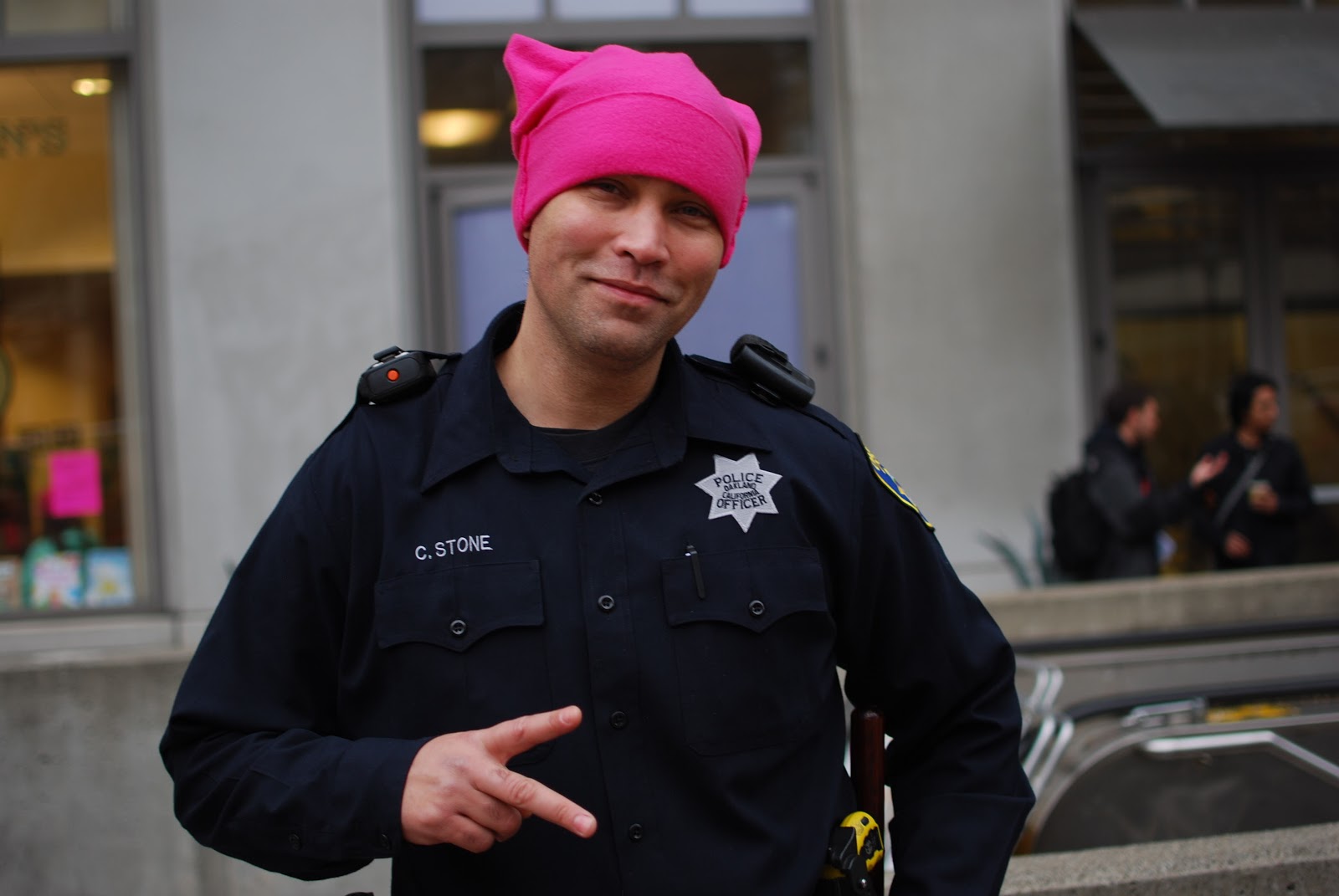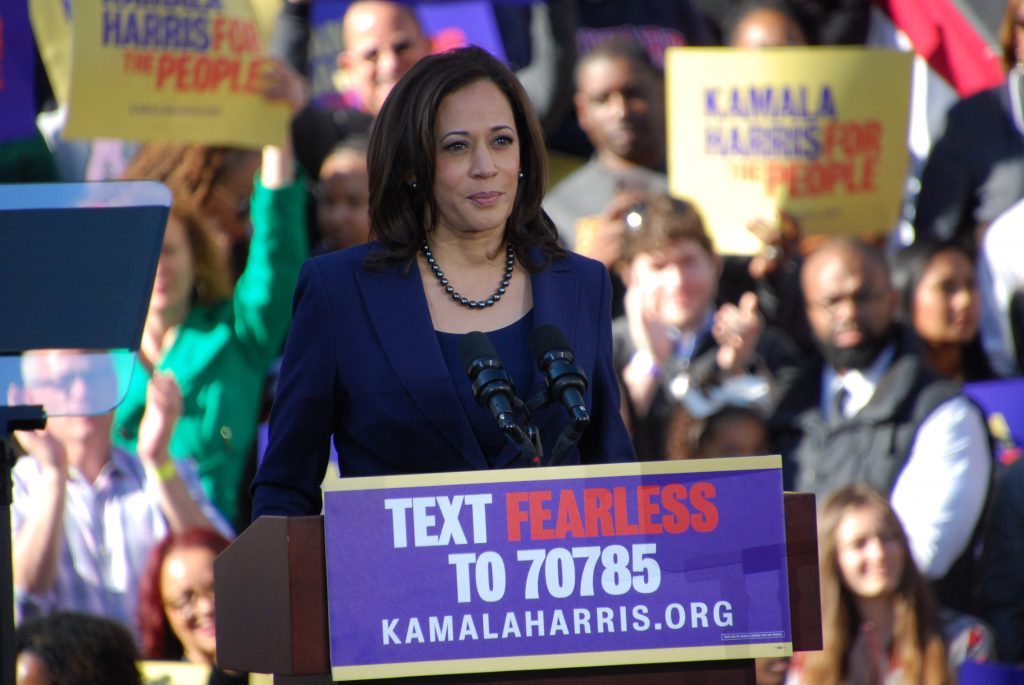During the massive Women’s Marches that drew millions of people into the streets on Saturday, scattered police officers in cities across the country were spotted donning “pussy hats,” pink knitted hats that became a symbol of the marches. Some women snapped selfies with the smiling officers, something that many pointed out would be extremely unlikely at a Black Lives Matter or similar march. The controversy highlighted some already contentious debates about how race and intersectionality should be addressed in the Women’s March.
“Don’t forget: White women voted for Trump,” read one sign carried by a black woman at the Washington, D.C. march. “I’ll see you nice white ladies at the next #BlackLivesMatter march, right?” read another. Even the pussy hats themselves became controversial as some critics pointed out that they excluded transgender women who might not have vaginas and that “not all pussies are pink.”
The photos with police officers wearing the pink hats added another dimension to the racial debate. Police shootings have been the subject of numerous protests in recent years and data has repeatedly borne out that police departments disproportionately target minority groups for enforcement and more often use force in those interactions. The country’s largest law enforcement union, the Fraternal Order of Police, endorsed Trump for president and supports his controversial Attorney General pick, Senator Jeff Sessions. Even the modest policing reforms made under President Barack Obama are under threat by the Trump Administration, which posted on the White House website, “The dangerous anti-police atmosphere in America is wrong. The Trump Administration will end it.”
While many applauded the participation of police officers in the Women’s March, some argued that it undermined this ongoing struggle. Reports that there were no arrests at the permitted, daytime marches were lauded as evidence of the peacefulness of the participants without considering that black-led protests against police are often policed far differently.
Police departments themselves have long struggled with gender representation. According to the U.S. Justice Department, only 13 percent of police nationwide are women, up from only 2 percent in the 1970s. A 2013 newsletter for the Justice Department’s Community Oriented Policing Services Office reported that, “Women in law enforcement are often inexplicitly resented by their male counterparts and many face harassment. Additionally, many women encounter a ‘brass’ ceiling and are unable to rise to supervisory positions despite their qualifications.”
In Oakland, where photos of one police officer in a pussy hat at the end of the march became popular online, the gender disparity is the same: only 13 percent of the department are women, according to city data. While Anne Kirkpatrick will become the first woman to head the Oakland Police Department next month, most of the command staff are men and she was appointed only after three men left the chief’s position in about 10 days amid a scandal involving department officers exploiting an underage victim of sex trafficking.
The then 17-year-old girl was reportedly running from a pimp when Officer Brendan O’Brien found her and the two started a sexual relationship. O’Brien later killed himself and implicated other officers in a suicide note, but some continued having sexual relationships with the girl while department superiors kept it quiet. U.S. District Judge Thelton Henderson slammed the slow progress of the investigation; it took nearly a year after O’Brien’s suicide for any of the officers involved to face consequences. Four current and former Oakland police officers ultimately faced criminal charges in the case along with two officers from other departments.
That scandal led to some of the most pointed criticism of the officer in the pink hat, Charles Stone, who wore both a symbol of feminism and the uniform of a department that Mayor Libby Schaaf described as a “frat house.”
There is no indication that Stone himself was involved in the scandal or cover up. In fact, he has at times been held up as an example of the more positive aspects of the Oakland Police Department: he is originally from Oakland and continues to live in the city, one of only 10 percent of officers who live in Oakland, and he was one of a group of officers who greeted an Oakland high school band who knelt in protest while playing the National Anthem before an Oakland A’s game last year. According to the school district, Stone showed the students a copy of Time magazine that mentioned them and told them he was proud of them. Stone was also one of three Oakland police officers who helped deliver a baby at an East Oakland gas station in 2012.
Some have also criticized the officers donning the pussy hats on the basis that they’re making a political statement while on duty. It is usually against department policies for officers to participate in any kind of political activity and officers making on-duty statements has stirred controversy in the past. A group of Texas police officers were punished for putting on “Make America Great Again” hats while escorting then-presidential candidate Donald Trump last year. Just north of Oakland in Richmond, then-police Chief Chris Magnus was called out by the city’s Police Officers Association for holding a “Black Lives Matter” sign briefly at a small protest in 2014.
It wasn’t clear if any of the officers spotted in the “pussy hats” would face discipline.



